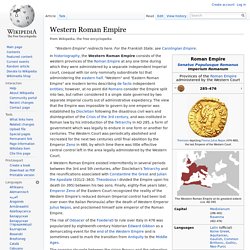

Ancient Rome. In its approximately 12 centuries of existence, Roman civilization shifted from a monarchy to a classical republic and then to an increasingly autocratic empire.

Through conquest and assimilation, it came to dominate Southern and Western Europe, Asia Minor, North Africa, and parts of Northern and Eastern Europe. Rome was preponderant throughout the Mediterranean region and was one of the most powerful entities of the ancient world. It is often grouped into "Classical Antiquity" together with ancient Greece, and their similar cultures and societies are known as the Greco-Roman world. Roman Empire. Western Roman Empire. The rise of Odoacer of the Foederati to rule over Italy in 476 was popularized by eighteenth-century historian Edward Gibbon as a demarcating event for the end of the Western Empire and is sometimes used to mark the transition from Antiquity to the Middle Ages.

Background[edit] As the Roman Republic expanded, it reached a point where the central government in Rome could not effectively rule the distant provinces. Byzantine Empire. The Byzantine Empire, alternatively known as the Eastern Roman Empire, was the predominantly Greek-speaking eastern half continuation and remainder of the Roman Empire during Late Antiquity and the Middle Ages.

Its capital city was Constantinople (modern-day Istanbul), originally founded as Byzantium. It survived the fragmentation and fall of the Western Roman Empire in the 5th century AD and continued to exist for an additional thousand years until it fell to the Ottoman Turks in 1453. During most of its existence, the empire was the most powerful economic, cultural, and military force in Europe. Roman Timeline.